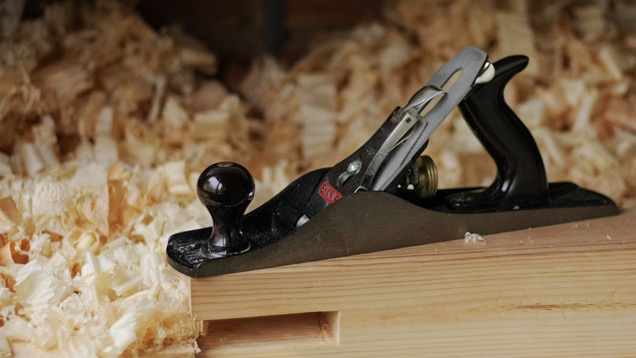Hand planes are elegant tools that if properly cared for will last a lifetime. Here’s how to use them, and how to keep them in good condition; ready for every occasion. Planes are used to straighten, smooth and remove wood. From shaving the bottom of a door to smoothing a desk surface, a hand plane will get the job done easily, while providing the the most comfort.
Photo by Phil Gradwell.
Jointers, power planers and sanders can all do the same job as hand planes but they can be too heavy handed for delicate woodworking tasks. Using these tools, you won’t feel the resistance of shaving a very thin piece of wood that you do with a hand plane.
Types of Hand Planes
Hand planes are often referred to as “bench planes” as they are mounted on a work bench, then adjusted to your needs.
Stanley is the first name in hand planes and they number their planes according to size from the smallest being a number 1 to a number 8. Smaller planes are used as smoothing planes and the larger/longer planes are used for jointing (flattening stock).
Despite the effectiveness of power tools, a Stanley 4 bench plane or Lie-Nielsen 4 1/2 will have many uses in your wood shop.
Adjusting a Hand Plane
To dial in a hand plane for use, you need to set the lateral (side to side) blade adjustment and the blade depth. Place your thumb against the blade and the bottom of the plane. That should give you a feel for what the blade setting should be. With experience you will be able to adjust your plane based on what your thumb tells you. Remember, you can always trim down more, but you can’t add material back, so start lighter than you might expect.
A proper lateral adjustment ensures the blade cuts equally on both sides and should be fine tuned using the lever located at the top of the rear handle.
The depth adjustment varies according to the type of job you are doing and how much material you want to shave off. Turn the dial located at the base of the plane to control the depth of the blade.
When not in use, set the plane straight down, not on it’s side. If you set it on it’s side it can throw the lateral adjustment out of whack and also expose the blade to damage.
Using a Hand Plane
Grasp a hand plane using both hands, one holding the rear handle and the other gripping the top front knob.
Place the plane at one end of your wood piece and move it forward. Lift, and repeat.
Always plane in the direction of the grain of the wood. Apply even downward pressure during the entire process. As you move, the plane should glide smoothly across the face of the wood. If it doesn’t, it’s likely you are not going with the grain.
Watch the video linked below for a more in-depth explanation on the variety of hand planes available and some more tips to use them.
How to Use Hand Planes [Heritage School of Woodworking (YouTube)]
Lifehacker’s Workshop column covers DIY tips, techniques and projects.

Comments
2 responses to “Tool School: The Elegant And Sturdy Hand Plane”
Glad to see we’ve gotten around to my favourite tool!
A point that could do with more clarification though:
Best to explain that this is achieved by controlling your weight on the plane throughout the movement, with your weight going towards the front at the start (when only the toe of the plane is in contact with the work), shifting to being evenly placed (when the whole plane sole is in contact with the work), and then shifting your weight towards the heel of the plane as the front of the plane glides off the work.
I found spokeshaves interesting, you can get straight ones and curved ones.